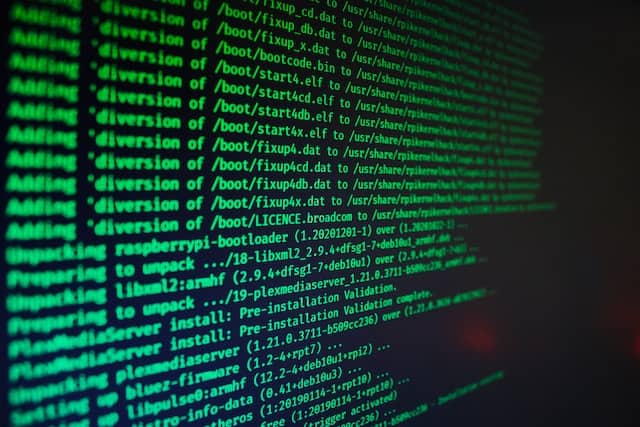Cybersecurity is an increasingly important consideration for businesses of all sizes. It is essential to understand and implement the best practices to ensure that data and systems remain secure from malicious attack.
In this article, we will discuss effective cybersecurity strategies such as:
- Developing a plan
- Providing training
- Creating an inventory
- Implementing access controls
- Using encryption
- Regularly testing systems
- Backing up data
- Protecting mobile devices.

Key Takeaways
- Training and awareness: Train employees on best practices for technology usage and increase awareness of security measures to ensure confidentiality of data and maintain strong security standards.
- Encryption and data security: Consider methods of securing networks and implement encryption for data storage and transfer to protect sensitive information from unauthorized access and comply with data security and privacy regulations.
- Policies and procedures: Implement guidelines for handling confidential information, specify when and how encryption should be applied, provide instructions for software and hardware tools, educate employees on system operation and compliance, and meet internal policies and external regulations.
- Testing and monitoring: Check for vulnerabilities in security systems, conduct third-party tests for improvement, audit access control measures, encryption, and authentication, implement security awareness programs, and establish policies for technology resource use and access control.
Develop a Plan
Developing a plan is an important step in implementing cybersecurity best practices for businesses. It should begin by identifying risks, which may include internal threats such as malicious code or external threats like hackers. This process requires businesses to review existing policies and procedures, assess technical safeguards, and evaluate personnel security protocols.
After assessing the risks, the plan should then outline appropriate steps to mitigate them. These steps might include creating or updating network access control policies, instituting employee education programs, and regularly performing vulnerability scans.
In order to ensure its success, it is important that all stakeholders are involved when developing the plan so that everyone understands their responsibilities and how they contribute towards protecting the organization from potential threats.
Once complete, the plan should be regularly reviewed in order to reflect any changes in technology or personnel that could impact security measures taken by the organization. A well-crafted cybersecurity plan can help secure data assets while also providing companies with peace of mind knowing they have taken necessary steps to protect themselves from malicious actors.
Provide Cybersecurity Training
Providing effective cybersecurity training is a key element of any business’s security plan. It is important to educate employees on the dangers of cyber threats as well as to discuss policies and procedures that will help protect both the company and its customers from potential risks.
Such training can provide employees with a better understanding of how to identify suspicious activity, respond appropriately, and protect their data against malicious actors.
Educate Employees

Educating employees on cybersecurity best practices is essential for businesses to protect their networks and data. To ensure that employees are aware of the latest security threats, companies must create and implement a comprehensive training program. This should include education around the types of threats that exist and how they can be prevented or mitigated. It should also involve regular updates on policies related to information security and monitoring of possible external or internal threats. Additionally, the creation of procedures to follow in case of a breach or attack is crucial.
In addition, it is important that employees understand their role in protecting the organization’s digital assets by following established protocols and adhering to sound security practices. This includes regularly changing passwords and avoiding suspicious links or files sent via email or other sources.
By providing regular education and training, companies can help reinforce good cybersecurity habits among its staff members. This will ultimately contribute to strengthening an organization’s overall information security posture.
Discuss Policies and Procedures
Establishing policies and procedures that outline security protocols is essential for safeguarding digital assets. Businesses should review their policies on a regular basis to ensure they remain up-to-date with the latest threats, and also establish guidelines for employee behavior when using company devices or networks. This will help to reduce the risk of data breaches and other malicious activities.
It is important for organizations to have these regulations in place, as it can result in more secure systems, improved compliance with industry standards, and better overall cyber hygiene. Additionally, having clear expectations about acceptable use can help employees understand how they are expected to act in order to maintain a secure environment. This includes getting familiarized with corporate policies and understanding best practices for managing passwords and data handling protocols.
With proper guidance from management personnel on cybersecurity best practices, businesses stand a greater chance at avoiding costly security breaches in the future.
Create an Inventory of Data and Systems
Creating an inventory of data and systems is a core cybersecurity best practice for businesses. Knowing what assets exist within the organization, including hardware, software, networks, and digital information, allows organizations to better understand their security needs.
A comprehensive asset inventory should be created and maintained as part of the review processes to assess risk. This includes identifying critical assets such as servers, databases, or cloud-based services that house sensitive data. Furthermore, all users who have access to these resources should be documented along with their credentials and permissions levels.
Organizations should also account for any third-party vendors that access the system or store sensitive data externally. By having an up-to-date list of assets and personnel with access to them, businesses can quickly identify potential vulnerabilities in order to limit exposure to malicious actors and secure their environment accordingly.
Keeping track of all digital resources is essential for staying ahead of cyber threats and safeguarding valuable corporate information.

Implement Access Controls
Implementing access controls is essential for maintaining the security of digital resources within an organization. Access control involves setting up rules and restrictions that determine who has access to the organization’s systems, networks, data, and other resources.
Password policies are a key component of access control because they define how users must authenticate their identity. In addition to passwords, organizations should also consider implementing two-factor authentication measures.
Access restrictions can be set at the user level so that only authorized personnel have access to certain areas or resources. Organizations should also consider using encryption for data in transit and at rest, as well as establishing a regular backup routine to ensure that important information is securely stored away from possible threats.
Organizations should also implement monitoring tools to detect suspicious activity on their systems or networks and take appropriate action if any security incidents occur. An effective cybersecurity policy should include clear guidelines on acceptable use of technology by employees, along with training programs that keep them informed about best practices in terms of online safety and security procedures.
By taking these steps, businesses can protect their digital assets from malicious attacks while still enabling employees to use technology safely and productively.
Implement Network Security
Network security involves the use of technologies and protocols to protect a network from unauthorized access and malicious activity. In order to secure networks, businesses must evaluate risks associated with potential threats, as well as the financial resources needed to develop a comprehensive security plan. Companies should also determine their risk threshold by determining what level of vulnerability is acceptable, depending on their size and industry.
It is important for businesses to have an understanding of different types of network attacks that could potentially occur. This includes denial-of-service (DoS) attacks, which involve flooding a server or website with traffic in order to prevent legitimate users from accessing it; man-in-the-middle (MiTM) attacks, which is when an attacker intercepts data sent between two parties; and phishing attacks, where attackers send emails pretending to be from trusted sources in order to gain confidential information.
Businesses should also create policies outlining how employees can safely use technology without compromising the safety of the company’s data. These policies should include rules regarding passwords, encryption techniques used for sensitive data, storage limitations for personal devices such as laptops or phones connected to the network, and guidelines for using social media on company computers. Additionally, companies can implement firewalls and antivirus software in order to provide an extra layer of security against potential threats.
In addition to these protective measures, businesses should conduct regular audits in order to identify any gaps in their cybersecurity system that may need further attention. Audits are also useful in identifying areas where additional training may be required so that employees are aware of best practices when using technology within the workplace environment. Implementing these measures allows businesses to maintain strong security standards while ensuring that confidential data remains protected at all times.
Use Encryption
It is important to consider the various methods of securing networks to ensure data confidentiality. One such method that businesses should consider is encryption. Encryption allows data to be stored and transferred securely, protecting it from unauthorized access by encoding it so that only those with the appropriate key can read or view its contents. By encrypting data, businesses can protect sensitive information from malicious actors that may seek to use it for nefarious purposes. Furthermore, encryption also helps organizations comply with regulations related to data security and privacy, such as GDPR and HIPAA.
Encryption relies on cryptographic algorithms which are used to scramble plaintext into ciphertext which cannot be deciphered without a key. Organizations have the option of either symmetric-key cryptography where one key is used for both encryption and decryption or asymmetric-key cryptography where separate keys are used for each process. While symmetric-key cryptography is faster, public-private key pairs are more secure as they provide better protection against brute force attacks and require less management overall.
In addition to encryption technology, organizations should also implement policies and procedures regarding how their staff handle confidential information such as passwords or credit card numbers. These policies should include guidelines on when and how encryption needs to be applied along with specific instructions on what type of software solutions or hardware tools need to be used in order for this goal to be achieved successfully. Additionally, organizations must educate their employees about how these systems work in order to ensure compliance with internal policies as well as external regulations like GDPR or HIPAA.
By utilizing strong encryption technologies combined with comprehensive policy guidelines regarding the handling of confidential information, businesses can significantly reduce their risk exposure in terms of cyberattacks or data breaches while meeting regulatory requirements at the same time. Taking these steps will help ensure that their networks remain secure while protecting customer privacy too.

Regularly Test and Monitor Security Systems
Regularly testing and monitoring security systems is essential for maintaining an organization’s cyber-resilience. This involves regularly checking the system for any potential vulnerabilities, as well as conducting third party tests to identify any areas where the system could be improved or updated. System audits should be conducted regularly to ensure that all data is properly secured and not vulnerable to malicious attacks. The audit should cover access control measures, encryption technologies, authentication methods, and other security protocols that are in place within the system.
Organizations must also consider implementing a security awareness program which will help staff understand how they can protect themselves from potential cyber threats. This includes educating employees on topics such as phishing attacks, malware prevention, password protection, and secure online practices. Furthermore, it is important for organizations to have a policy in place regarding acceptable use of technology resources and access control measures. This ensures that all personnel are aware of their responsibilities when using company assets or systems.
Regular testing and monitoring of cybersecurity best practices helps ensure that organizations remain secure against external threats while protecting their digital assets from unauthorized access or modification. Additionally, regular review of existing policies allows organizations to stay informed about new developments in cybersecurity so they can keep up with the latest trends in the industry. By taking these steps towards ensuring cyber-resilience, businesses can protect their information from being compromised by malicious actors while still allowing them to maximize profits through efficient operations.
Implement Backup and Recovery Plans
Implementing a backup and recovery plan is an essential component of ensuring digital continuity in the event of a cyber attack or system failure. Businesses should regularly test their backup and recovery plans to ensure that they can be recovered when needed, as well as conduct audits to identify any potential weaknesses.
- Backup & Recovery Plans:
- Regularly test plans to identify any issues
- Conduct periodic audits to detect any weaknesses
- Disaster Recovery Options:
- Have multiple backups stored off-site in case of emergency
- Investigate cloud solutions for increased data redundancy
Having a comprehensive backup and recovery plan in place is one of the best ways for businesses to protect themselves against cyber attacks. It allows them to quickly restore operations without losing data or access to critical information. In addition, it also creates greater awareness among staff about good security protocols, increasing the overall level of security within the organization.
With these measures in place, businesses will have peace of mind knowing that their systems are protected against malicious actors.
Protect Mobile Devices

The effectiveness of backup and recovery plans is essential in protecting businesses against data loss or theft. To further ensure the security of business data, mobile devices must also be adequately safeguarded.
Mobile devices have become an integral component of modern businesses, allowing employees to access corporate networks and applications from a variety of locations. However, these same devices can potentially be exploited by malicious actors if not properly secured. Protecting mobile devices requires that businesses establish policies that limit employee access to sensitive information while ensuring secure network connections.
To protect user data on mobile devices, organizations should consider implementing multi-factor authentication (MFA) for any accounts accessed through a smartphone or tablet device. MFA requires users to enter two forms of credentials before gaining access to their account, such as entering both a password and receiving an authorization code sent via SMS message or email. This additional layer of security can help prevent unauthorized access even if one credential is compromised. Furthermore, organizations should restrict the use of public Wi-Fi networks when accessing company resources as they are unencrypted and susceptible to attack from cybercriminals.
Organizations should also require employees to update their mobile device’s operating system regularly with the latest security patches released by the manufacturer. Additionally, it is important for companies to develop an appropriate response plan in case any suspicious activity is detected on a device used for corporate activities such as someone attempting to gain unauthorized access or installing malware without permission.
With the proper safeguards in place, companies can ensure that their data remains protected regardless if it is stored locally or remotely accessed through a mobile device.
By implementing comprehensive policies designed specifically for mobile devices along with other cybersecurity best practices, businesses can create an effective defense against potential attacks from malicious actors while preserving user privacy at all times.
Frequently Asked Questions
How do I know which security measures are best for my business?
In order to determine the best security measures for a business, it is important to assess risks and provide employees with proper training. This will ensure that any potential vulnerabilities are identified and addressed in an effective manner.
Does my business need cyber liability insurance?
Businesses should consider cyber liability insurance to protect against potential financial losses from cyber threats. An effective risk assessment process is key to determining the right level of coverage for a business.
How often should I perform security testing?
Security testing should be regularly performed, with patch schedules implemented to ensure data protection. It is important to keep these processes up-to-date in order to identify any potential security risks.
How should I respond if a data breach occurs?
In the event of a data breach, organizations should implement backup strategies and employee training to reduce risk. A thorough assessment is necessary to identify any potential vulnerabilities and ensure proper response protocols are in place.
What should I do if I suspect my business is the target of a cyber attack?
Suspecting a cyber attack requires quick action: identify the risk, evaluate potential solutions, and take appropriate steps to protect the business. Timely response is key to minimizing damage and protecting data.
Conclusion
Businesses of all sizes should make cybersecurity best practices an integral part of their operations.
By developing a plan, providing training, creating an inventory, and implementing access controls, businesses can reduce the risk posed by cyber attackers.
Securing networks, using encryption, testing and monitoring systems, backing up data, and protecting mobile devices are also important steps in maintaining cybersecurity.
As technology continues to evolve at a rapid pace, businesses must stay vigilant and proactive in order to ensure that their data remains secure.
